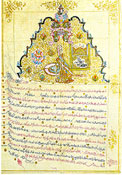 |
||||||||||||||||||||
 |
||||||||||||||||||||
 |
||||||||||||||||||||
 |
||||||||||||||||||||
|
Analyzing Documents presents case studies that demonstrate how scholars interpret different kinds of historical evidence in world history. Here are excerpts from two official proclamations by the government of the Ottoman Empire. Both texts are part of the Ottoman government’s response to internal and external demands for reform stemming from the growing weakness of the state. They reflect an understanding by the ruling elites that some administrative reform was absolutely necessary to protect the state from further decay. Although they are presented as the word of the Emperor, official proclamations such as these are typically the result of complex negotiations within a government over form as well as substance. For this reason, historians often learn much about that internal debate from the final form of the text.
Read these two selections, paying attention to both the words the authors chose and the meaning of those words for audiences within the Empire and in Europe. What do you notice about each text? How are they similar? How are they different? Why do you think the second text is more specific? What does this tell you about the state of affairs in the Empire in 1856 as compared to 1839? What can we understand about the law in the Ottoman Empire from these two documents? What can we learn about the internal debate within the Ottoman government over reform from reading and comparing these two texts? These are all questions historians ask when they read official documents such as these.
Now listen to Professor Dina Khoury talk about the documents and what we can learn from them.
|
||||||||||||||||||||||||||||||||||||||||||||||||||
|
finding world history | unpacking evidence | analyzing documents | teaching sources | about |
|

